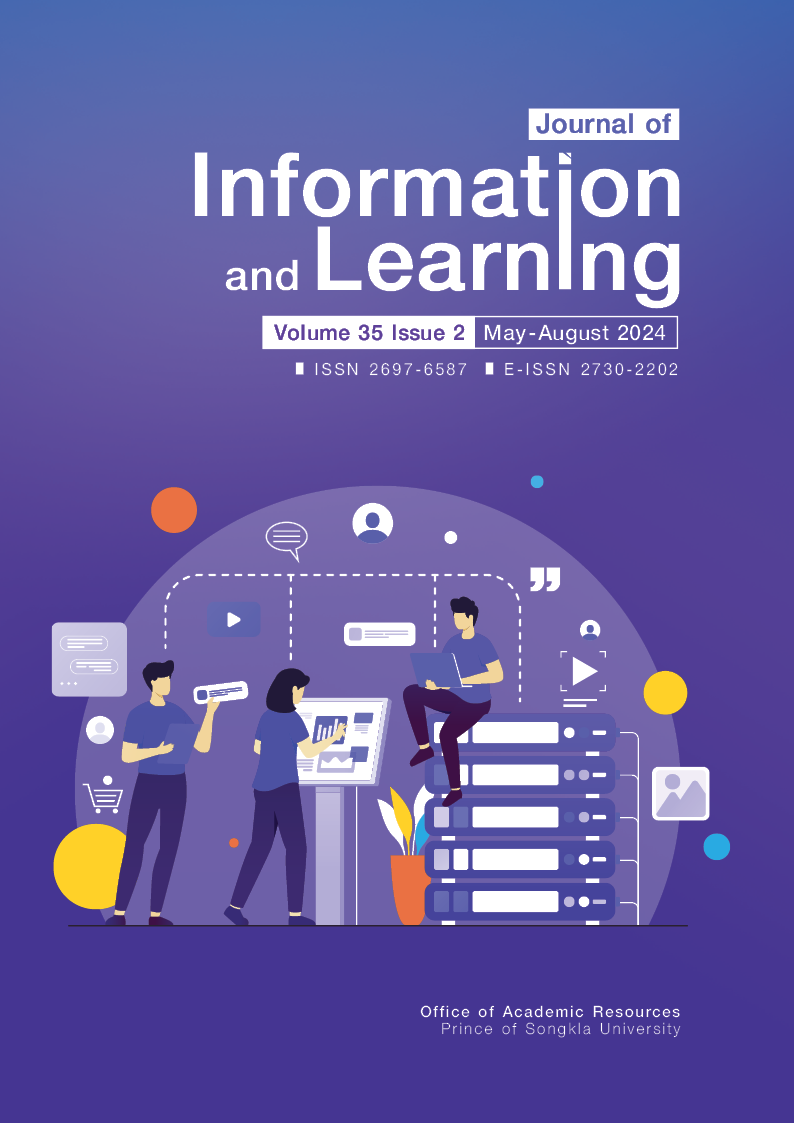The Design of Learning Media to Reduce Cognitive Load Using the Split-Attention Principle
Main Article Content
Abstract
The design of learning media aims for learners to study content in order to create their own knowledge. During the learning process, learners experience cognitive load depending on the difficulty of content and the design of learning media. When learning materials comprise diverse formats, such as text, images, audio, or video, inappropriate or inconsistent content placement may lead to a phenomenon known as the split-attention effect. This phenomenon occurs when learners need to allocate cognitive resources to gather and link information from separate sources, resulting in unnecessary cognitive load. And if cognitive load exceeds learners' limits or cognitive overload occurs, it will affect learning efficiency. Therefore, this article explains the principles of human information processing and memory limitations that cause cognitive load. It then presents media design that reduces cognitive load using the principle of reducing split attention, examples of learning media design using the principle of reducing split attention, and the impact of the principle of reducing split attention on learning media design as a guideline for future learning media design.
Article Details

This work is licensed under a Creative Commons Attribution-NonCommercial-NoDerivatives 4.0 International License.
The Journal of Information and Learning is operated by the Office of Academic Resources, Prince of Songkla University. All articles published in the journal are protected by Thailand copyright law. This copyright covers the exclusive rights to share, reproduce and distribute the article, including in electronic forms, reprints, translations, photographic reproductions, or similar. Authors own copyrights in the works they have created as well as the Office of Academic Resources. The Journal reserves the right to edit the language of papers accepted for publication for clarity and correctness, as well as to make formal changes to ensure compliance with the journal's guidelines. All authors must take public responsibility for the content of their paper.
References
Atkinson, R. C., & Shiffrin, R. M. (1968). Human memory: A proposed system and its control processes. In K. W. Spence, & J. T. Spence (Eds), The psychology of learning and motivation (pp. 89-195). Academic Press. https://doi.org/10.1016/S0079-7421(08)60422-3
Ayres, P., & Sweller, J. (2005). The split-attention principle in multimedia learning. In R. E. Mayer (Ed.), The cambridge handbook of multimedia learning (pp. 135-146). Cambridge University Press. https://doi.org/10.1017/CBO9780511816819.009
Chaijaroen, S. (2016). Educational technology: Theoretical principles into practice. Penprinting.
Clark, R. C., Nguyen, F., Sweller, J., & Baddeley, M. (2006), Efficiency in learning: Evidence-based guidelines to manage cognitive load. Performance Improvement, 45(9), 46-47. https://doi.org/10.1002/pfi.4930450920
de Koning, B. B., Rop, G., & Paas, F. (2020). Effects of spatial distance on the effectiveness of mental and physical integration strategies in learning from split-attention examples. Computers in Human Behavior, 110, Article 106379. https://doi.org/10.1016/j.chb.2020.106379
Klausmeier, H. J. (1985). Educational psychology (5th ed.). Harper & Row.
Liu, Y., Jang, B. G., & Roy-Campbell, Z. (2018). Optimum input mode in the modality and redundancy principles for university ESL students’ multimedia learning. Computers & Education, 127(3), 190-200. https://doi.org/10.1016/j.compedu.2018.08.025
Lutz, S., & Huitt, W. (2018). Information processing and memory: Theory and applications. In W. Huitt (Ed.), Becoming a Brilliant Star: Twelve core ideas supporting holistic education (pp. 25-43). IngramSpark. http://www.edpsycinteractive.org/papers/2018-02-lutz-huitt-brilliant-star-information-processing.pdf
Michael, T., Sebastian, K., Martin, P. S., Fabian, B., Paul L., & Jochen, K. (2020). Effects of augmented reality on learning and cognitive load in university physics laboratory courses. Computers in Human Behavior, 108(106316). 1-11. https://doi:10.1016/j.chb.2020.106316
Rey, G. D., Beege, M., Nebel, S., Wirzberger, M., Schmitt, T. S., & Schneider, S. (2019). A meta-analysis of the segmenting effect. Educational Psychology Review, 31, 389-419. https://doi.org/10.1007/s10648-018-9456-4
Renkl, A. (2005). The worked-out examples principle in multimedia learning. In R. E. Mayer (Ed.), The cambridge handbook of multimedia learning (pp. 229-246). Cambridge University Press. https://doi.org/10.1017/CBO9780511816819.016
Sweller, J. (2020). Cognitive load theory and educational technology. Educational Technology Research and Development, 68, 1-16. https://doi.org/10.1007/s11423-019-09701-3
Sweller, J. (2005). Implications of cognitive load theory for multimedia learning. In R. E. Mayer (Ed.), The Cambridge handbook of multimedia learning (pp. 19-30). Cambridge University Press. https://doi.org/10.1017/CBO9780511816819.003
Sweller, J., Ayres, P., & Kalyuga, S. (2011). Intrinsic and extraneous cognitive load. In J. M. Spector, & S. P. Lajoie (Eds.). Cognitive load theory (pp 57-69). Springer. https://doi.org/10.1007/978-1-4419-8126-4_5
Sweller, J., van Merriënboer, J. J. G., & Paas, F. (2019). Cognitive architecture and instructional design: 20 Years later. Educational Psychology Review, 31(2), 261-292. https://doi:10.1007/s10648-019-09465-5
Thees, M., Kapp, S., Strzys, M. P., Beil, F., Lukowicz, P., & Kuhn, J. (2020). Effects of augmented reality on learning and cognitive load in university physics laboratory courses. Computers in Human Behavior, 108, Article 106316. https://doi.org/10.1016/j.chb.2020.106316
Tulving, E. (1972). Episodic and semantic memory. In E. Tulving, & W. Donaldson (Eds.). Organization of memory (pp. 381-403). Academic Press.
Ward, M., & Sweller, J. (1990). Structuring effective worked examples. Cognition and Instruction, 7(1), 1-39. https://doi.org/10.1207/s1532690xci0701_1


